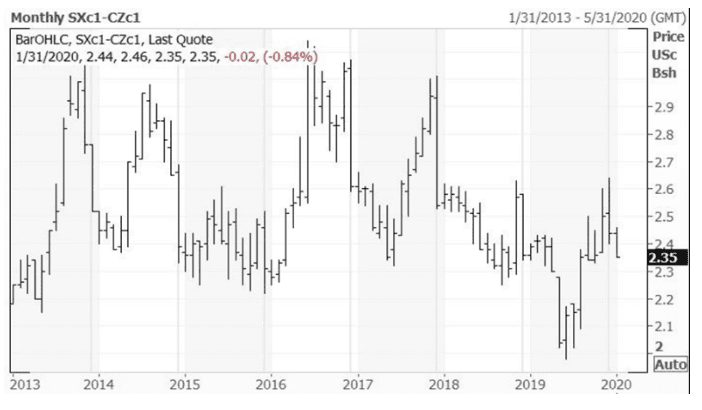February is a crucial month for many U.S. growers of summer crops as prices during this period help to drive planting intentions for the upcoming growing season. The ratio of the harvest, November soybean futures contract relative to the corresponding new-crop corn futures measured with the December contract, provides many growers that are able to rotate land between corn and soybeans with assessments as to relative crop returns. This ratio is a popular guideline for analysts to gauge planting potentials ahead of the U.S. Department of Agriculture’s (USDA) March intentions report, and the monthly-average settlement of the November contract will be used by USDA’s Risk Management Agency to determine projected prices for some of its crop insurance programs including the popular revenue and yield protection plans.
The current price relationship between corn and soybean futures favors corn plantings over soybeans in many regions when looking ahead to the 2020 growing season. The accompanying chart plots the monthly ranges of the ratios of November soybean futures prices to December corn futures prices, calculated daily, since 2013. The lower the ratio, the more favorable are the marginal returns over production costs for corn over soybeans. Likewise, the higher the ratio, the more favorable are the marginal returns for soybean production over corn.

While there is periodic volatility in the ratio’s calculation, the lower end of the range tends toward 2.30:1. The most prominent exception to the downside was last spring when it became apparent that weather was causing major disruptions to corn plantings. Prices adjusted to present a major incentive to continue planting corn instead of switching to soybeans as the ratio plunged toward 2.0:1. The upper end to the normal range is about 2.60:1. That is the upper end during the planting season. There are several years when the ratio was much higher than that during the back half of the calendar year, but not an influence any longer on that year’s planting decisions.
During late January 2020, the ratio was weakening at 2.35:1. This placed the ratio in the lower half of the usual price range and likely to find farmers first considering more corn acres than soybean acres as they restored overall plantings from 2019. Key market features that are expected to influence U.S. farmers’ planting intentions outside of weather in 2020 include Chinese purchases of U.S. agricultural products including those of corn and corn-based products such as distillers dried grains (DDGs) and corn-based ethanol along with the ultimate size of South American soybean and corn crops. These factors are expected to help determine the soybean to corn price ratio this spring and the resulting price relationship will serve as a barometer for the market when determining acreage potential for the upcoming 2020 growing season.
